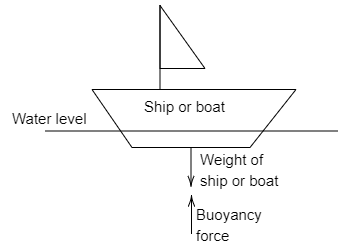
A heavy ship floats in water because
A) its density is less than that of water
B) its relative density is less than that of water
C) its average density is less than that of water
D) its density is equal to that of water
Answer
140.1k+ views
Hint: When the ship floats on the water, it is due to the reaction force exerted by the fluid. The weight of the ship is vertically downward and the reaction force is vertically upwards, if the reaction force is maximum the ship will float. The ship will float on the water by the Archimedes principle or buoyancy principle.
Complete step by step solution:
The Archimedes principle states that the force exerted by the object to the fluid is equal to the weight of the fluid displaced by the object. Then the force is called buoyant force. The buoyant force helps the ship to float on the water, as it pushes the object upwards. If the object density is less than that of the density of the water, it floats. It helps the ship to float on the water. If the density is more than the density of water it sinks.

And there are three types of buoyancy forces, they are positive buoyancy force, negative buoyancy force and the neutral buoyancy force. So, here positive buoyancy force helps the ship to float on the water. And also, the density of water is also taken into consideration, so the relative velocity of the ship and the air must be less than the density of water, then only the ship will float on the water.
Hence, the option (C) is the correct answer.
Note: The total volume of the ship displaced in the water must be greater than the weight of the ship. From the figure, the violet coloured area is the volume of the ship displaced into the water, it must be greater than the weight of the ship. Then only the ship will float on the water, otherwise it sinks.
Complete step by step solution:
The Archimedes principle states that the force exerted by the object to the fluid is equal to the weight of the fluid displaced by the object. Then the force is called buoyant force. The buoyant force helps the ship to float on the water, as it pushes the object upwards. If the object density is less than that of the density of the water, it floats. It helps the ship to float on the water. If the density is more than the density of water it sinks.

And there are three types of buoyancy forces, they are positive buoyancy force, negative buoyancy force and the neutral buoyancy force. So, here positive buoyancy force helps the ship to float on the water. And also, the density of water is also taken into consideration, so the relative velocity of the ship and the air must be less than the density of water, then only the ship will float on the water.
Hence, the option (C) is the correct answer.
Note: The total volume of the ship displaced in the water must be greater than the weight of the ship. From the figure, the violet coloured area is the volume of the ship displaced into the water, it must be greater than the weight of the ship. Then only the ship will float on the water, otherwise it sinks.
Recently Updated Pages
Difference Between Circuit Switching and Packet Switching

Difference Between Mass and Weight

JEE Main Participating Colleges 2024 - A Complete List of Top Colleges

JEE Main Maths Paper Pattern 2025 – Marking, Sections & Tips

Sign up for JEE Main 2025 Live Classes - Vedantu

JEE Main 2025 Helpline Numbers - Center Contact, Phone Number, Address

Trending doubts
JEE Main 2025 Session 2: Application Form (Out), Exam Dates (Released), Eligibility, & More

JEE Main 2025: Derivation of Equation of Trajectory in Physics

JEE Main Exam Marking Scheme: Detailed Breakdown of Marks and Negative Marking

Learn About Angle Of Deviation In Prism: JEE Main Physics 2025

Electric Field Due to Uniformly Charged Ring for JEE Main 2025 - Formula and Derivation

JEE Main 2025: Conversion of Galvanometer Into Ammeter And Voltmeter in Physics

Other Pages
Units and Measurements Class 11 Notes: CBSE Physics Chapter 1

JEE Advanced Marks vs Ranks 2025: Understanding Category-wise Qualifying Marks and Previous Year Cut-offs

NCERT Solutions for Class 11 Physics Chapter 1 Units and Measurements

Motion in a Straight Line Class 11 Notes: CBSE Physics Chapter 2

Important Questions for CBSE Class 11 Physics Chapter 1 - Units and Measurement

NCERT Solutions for Class 11 Physics Chapter 2 Motion In A Straight Line




